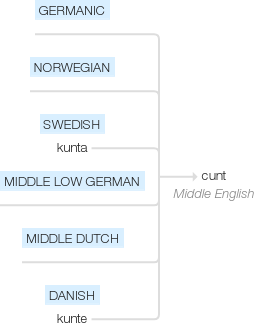Cunt
Middle English: of Germanic origin; related to Norwegian and Swedish dialect kunta, and Middle Low German, Middle Dutch, and Danish dialect kunte .
wiktionary
From Middle English cunte, queynt, queynte, from Old English *cunte, from Proto-Germanic *kuntǭ. Cognate with West Frisian kunte, Middle Dutch conte (Dutch kont(“butt”)), dialectal Swedish kunta, dialectal Danish kunte, and Icelandic kunta. A relationship to Latin cunnus has not been conclusively shown. Partridge suggests cuneus(“a wedge”).
etymonline
cunt (n.)
"female intercrural foramen," or, as some 18c. writers refer to it, "the monosyllable," Middle English cunte "female genitalia," by early 14c. (in Hendyng's "Proverbs" — ʒeve þi cunte to cunni[n]g, And crave affetir wedding), akin to Old Norse kunta, Old Frisian, Middle Dutch, and Middle Low German kunte, from Proto-Germanic *kunton, which is of uncertain origin. Some suggest a link with Latin cuneus "wedge" (which is of unknown origin), others to PIE root *geu- "hollow place," still others to PIE root *gwen- "woman."
The form is similar to Latin cunnus "female pudenda" (also, vulgarly, "a woman"), which is likewise of disputed origin, perhaps literally "gash, slit" (from PIE *sker- "to cut") or "sheath" (Watkins, from PIE *(s)keu- "to conceal, hide"). De Vaan rejects this, however, and traces it to "a root *kut-meaning 'bag', 'scrotum', and metaphorically also 'female pudenda,' " source also of Greek kysthos "vagina; buttocks; pouch, small bag" (but Beekes suspects this is a Pre-Greek word), Lithuanian kutys "(money) bag," Old High German hodo "testicles."
Hec vulva: a cunt. Hic cunnus: idem est. [from Londesborough Illustrated Nominale, c. 1500, in "Anglo-Saxon and Old English Vocabularies," eds. Wright and Wülcker, vol. 1, 1884]
First known reference in English apparently is in a compound, Oxford street name Gropecuntlane cited from c. 1230 (and attested through late 14c.) in "Place-Names of Oxfordshire" (Gelling & Stenton, 1953), presumably a haunt of prostitutes. Used in medical writing c. 1400, but avoided in public speech since 15c.; considered obscene since 17c.
in Middle English also conte, counte, and sometimes queinte, queynte (for this, see Q). Chaucer used quaint and queynte in "Canterbury Tales" (late 14c.), and Andrew Marvell might be punning on quaint in "To His Coy Mistress" (1650).
"What eyleth yow to grucche thus and grone? Is it for ye wolde haue my queynte allone?" [Wife of Bath's Tale]
Under "MONOSYLLABLE" Farmer lists 552 synonyms from English slang and literature before launching into another 5 pages of them in French, German, Italian, Spanish, and Portuguese. [A sampling: Botany Bay, chum, coffee-shop, cookie, End of the Sentimental Journey, fancy bit, Fumbler's Hall, funniment, goatmilker, heaven, hell, Itching Jenny, jelly-bag, Low Countries, nature's tufted treasure, penwiper, prick-skinner, seminary, tickle-toby, undeniable, wonderful lamp, and aphrodisaical tennis court, and, in a separate listing, Naggie.] Dutch cognate de kont means "a bottom, an arse," but Dutch also has attractive poetic slang ways of expressing this part, such as liefdesgrot, literally "cave of love," and vleesroos "rose of flesh."
Alternative form cunny is attested from c. 1720 but is certainly much earlier and forced a change in the pronunciation of coney (q.v.), but it was good for a pun while coney was still the common word for "rabbit": "A pox upon your Christian cockatrices! They cry, like poulterers' wives, 'No money, no coney.' " [Philip Massinger: "The Virgin-Martyr," Act I, Scene 1, 1622]
